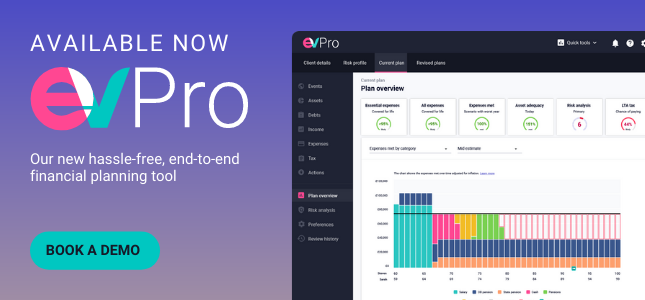How to generate a lifetime of sustainable income for your clients

In our latest article, we discuss a new approach to delivering a sustainable level of income to your clients, that ensures they avoid the risk of running out of money in retirement.
We’re regularly told there are no guarantees in life. But there used to be plenty in the retirement savings market, helping retirees replace their working income with something fixed and sustainable. In the current landscape, however, products with guarantees are hard to come by. And those that are available aren’t proving very attractive.
Historically, securing a sustainable lifetime income in retirement was reasonably straightforward, with the preferred solutions not exposed to the whims of financial markets. Many employees from the so-called ‘golden generation’ enjoyed defined benefit (DB) pension arrangements, benefitting from not only a guaranteed lifetime income but one that keeps pace with inflation. Even those without access to DB schemes, such as self-employed workers, were offered attractive annuity rates. None more so than holders of certain private pension arrangements, such as retirement annuity contracts, which offered guaranteed rates. Although dependent on the age at which benefits were drawn, rates north of 10% a year were very much the norm.
However, finding a sustainable retirement income in the current climate is somewhat trickier. Annuities are waning in popularity, with little sign of this arresting. And it’s easy to understand why. Due to a combination of people living longer and tumbling gilt yields, market annuity rates have plummeted. Meanwhile, in the private sector, DB schemes are edging closer to extinction, with most employers now offering defined contribution schemes.
But there are other factors at play here, too. The advent of pension freedoms in 2015 afforded retirees the flexibility and control long craved for, triggering an instant shift in sentiment from guarantees to income drawdown. But while the freedoms were universally welcomed, large swathes of retirees are now tasked with making sure their retirement funds last the distance – failure to adopt a prudent strategy could be catastrophic.
Product manufacturers have a pivotal role to play, too. It’s incumbent on us to develop tools and funds that are fit for purpose. The Financial Conduct Authority noted in its 2017 Retirement Outcomes Review that product innovation in the sector was initially sluggish. But things are now starting to move on this front.
For example, within our very own EVPro software, due for launch shortly, we’ve developed processes specifically designed to help advisers deliver a sustainable retirement income for their clients.
What is a realistic and safe withdrawal figure?
This is a question we see frequently cropping up. Perceived wisdom suggests an annual withdrawal of 4% will do the job. However, proponents of this approach claim that this should be reviewed at the start of every annual withdrawal period to account for inflation.
There are, however, several problems with this strategy. Firstly, it doesn’t account for any personalisation. The industry constantly emphasises the need for advice recommendations to be tailored to a client’s specific needs. Advising all clients to take the same course of action is strikingly at odds with this.
Secondly, a blanket withdrawal figure fails to take stock of the economic conditions at the point of retirement. Finally, drawing income from equities in bearish markets increases exposure to the sequencing of returns risk, thus hampering a portfolio’s ability to recover.
The efficient frontier below represents a set of optimal portfolios that offer the highest expected return for a defined level of risk. This means you can be confident that you are selecting a safe withdrawal rate that will deliver a sustainable income to meet your client’s financial needs in retirement at a risk level they are comfortable with.
.png?width=1582&name=image%20(17).png)
Measuring the right risk
We believe that a fresh approach is needed - many of the existing strategies are antiquated and, in some instances, dangerous. In our view, a successful sustainable income strategy should focus on three key elements: risk profile, risk rating, and rate of withdrawal.
Current risk profile questionnaires are primarily concerned with an investor’s ability to cope with volatility – otherwise known as ‘capital at risk’. For those in the process of accumulating retirement funds, this works perfectly well. However, this can be damaging when the objective is to generate a sustainable income; we need to measure a client’s income at risk.
Our EV Pro software has separate questionnaires for growth and income, meaning advisers can measure the appropriate risk for the client’s objective.
The same applies to risk-rating systems. We need to risk-rate funds and portfolios used for income drawdown in terms of income sustainability and not volatility. And while volatility must be considered, it should not be the primary focus.
It’s often assumed that the maximum income level taken from a drawdown arrangement is dictated mainly by the retiree’s longevity. And even though there is undeniable truth in this, few people know how long they will live, so anchoring retirement income strategies to this metric have flaws. Therefore, we established that an adequate, sustainable income solution should work independently from a client’s age and life expectancy.
We believe that developing tools that shift the focus from capital to income will create a healthier retirement market. For example, our EV Pro software enables our users to assess the appropriate risk profile for a given client and ensure their risk rating and rate of withdrawal are both suitable, putting them on track to achieving a much-treasured sustainable income.
The upshot is you will be able to generate a lifetime of sustainable income for your clients, and fewer drawdown clients will run out of money.
So what next?
We understand that this is a new approach to discussing income sustainability with your clients, so we have developed this handy guide.
Click here to download “An Adviser’s Guide to Supporting Income Objectives” to better understand the concept of ‘income at risk’ so you can;
- Learn why it’s essential to consider different risks when drawing an income for your client
- Differentiate between your clients’ growth and income objectives
- See how ‘income at risk’ can fit within your existing advice process
- Easily explain risk to your clients in a way that is easy to understand
